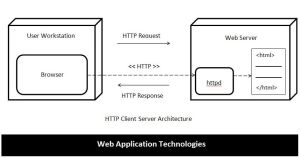Introduction to Web Application Technologies : Part-I
Now, In this article, I will introduce you to some of the common web application technologies, so let’s start with HTTP.
Web Application Technologies:
- The Hypertext Transfer Protocol (HTTP) is similar to many other Internet Protocols, for example Simple Mail Transfer Protocol (SMTP) and File Transfer Protocol (FTP), because HTTP is a protocol to transfer data from the server to the client.
- One fundamental difference between most other Internet protocols and HTTP is that the typical Internet protocol support several requests per connections, HTTP supports only one request per connection.
- This means that with HTTP the client connects to the server to retrieve one file and then disconnects. This mechanism allows more user to connect to a given server over a period of time.
- This mechanism is at the heart of why HTTP is referred to as a stateless protocol.There is no need for the server to hold the connection open, therefore the server does not need to manage the connection’s state.
- The stateless nature of HTTP is fundamental to the efficiency and scalability of what is called the World Wide Web.
- HTTP was created in conjunction with the related HTML standard. HTML is a document display language that lets users link from one document to another.
- For example, a paper about charmed quarks stored at the European Organization for Nuclear Research (CERN) in Switzerland could include a See also link to a paper on strange quarks on a computer on Fargo, North Dakota.
- HTML also permits images and other media objects to be embedded in a HTML document. The media objects are stored in a files on a server.
- HTTP also retrieves that files. Therefore, HTTP can be used to transmit any file that conforms to the Multipurpose Internet Mail Extension (MIME) specification.
- The combination of HTTP protocol and the HTML page description language constitutes the foundational technologies of the World Wide Web.
HTTP Client-Server Architecture:
- For every exchange over a web using the HTTP, there is a request and a response.
- The web server sends a single request to the server. The web server determines which file is being requested and sends the data in that file back as the response.
- The browser interprets the response and represents the content on the screen.
- The request information consists of the location of the file, or other resource that the user wants, and information about the browser. The response information contains the requested resource and other information.
- The request is typically in plain text. The response can be plain text or part plain text, part binary data. (Graphics, for example, must be sent in binary form.)
Web Site Structure:
- A web site is a collection of HTML pages and other media files that contains all the content that is visible to the user on a given web server.
- These files are stored on the server and might include a complex directory hierarchy. The web site is composed of that directory hierarchy.
Note: The index.html file is a special file used when the user requests a Uniform Resource Locator (URL)that ends with a slash character (/). The web server presents the user with a directory listing for that URL unless an index.html file exist in that directory. If that is the case, then the web server sends the index.html file as the response to the original URL.
Uniform Resource Locator (URL):
- A URL is a canonical name that locates a specific resource on It consists of:
protocol://host:port/path/file
- For example,
www.google.com/index.html
- The path element includes the complete directory structure path to find the file. The port number is used to identify the TCP port that is used by the protocol on the server.
- If the port number is the standard port for the given protocol, then that number can be ignored in the URL.
- For example, port 80 is the default HTTP port:
www.google.com/index.html
